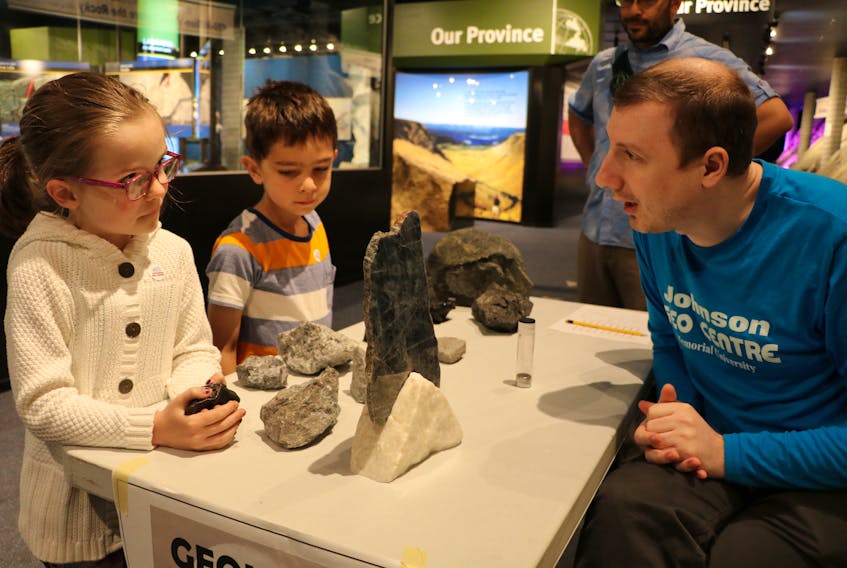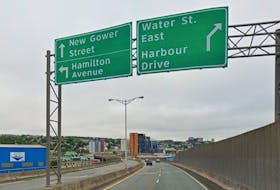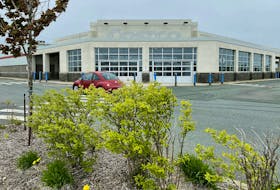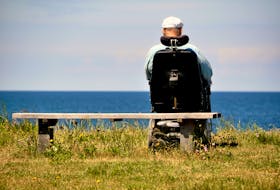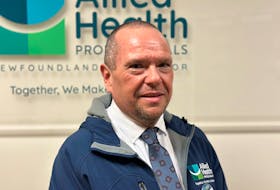ST. JOHN'S, N.L. — Sitting on a clear summer night gazing up at a bright full moon, it’s a little hard to image that humans landed there 50 years ago.
After all, it’s more than 384,000 kilometres away.
A century ago, such a feat would have been unimaginable.
The same, however, could be said about those who sat upon the shores of Europe looking at the vastness of the Atlantic ocean wondering if it would ever be crossed by ship or plane. Or if the highest mountains would ever be topped, or the depths of the ocean explored.

The Canadian Space Agency (CSA) and the Johnson Geo Centre held an event on Saturday at the Signal Hill facility to mark the 50 years since the Apollo 11 moon landing. A story marking such an important event has to contain astronaut Neil Armstrong’s first words as he stepped from the lunar lander unto the surface, "That's one small step for (a) man, one giant leap for mankind.”
After the novelty of the moon landings have worn off over the years since, the moon has suddenly become a cool rock once again.
Canadian astronaut Joshua Kutryk gave a presentation at the Geo Centre on Saturday and said astronauts will likely set foot on the moon again within the next five years or so.
He noted there were many Canadian engineers working behind the scenes in the space program that led to the first moon landing — an event that was as much as a cold war battle between Russia and the United States as it was a science and exploration mission.
The next moon missions will be a collective effort of a number of countries.
Kutryk says the fist moon landing was such an important event because it showed what the human race could do with innovation and that the ability exists to take something that was impossible for thousands of years and for generations, and to make it possible.
“It’s particularly important, I think, to think about the Apollo 11 50th today because we are talking right now about going back to the moon,” Kutryk said. “NASA is going back to the moon with its international partners. Canada is a partner in that adventure and we are helping to build the next space station that is going to orbit the moon, and this is something we are getting to work on right now, it is something that is going to be launched within the next few years.
“(We will) see a space station around the moon and people operating in a permanent and sustainable way on the surface of the moon. It’s all stuff that’s going to happen here in the next 10 years.
“There will be a Canadian on the moon eventually. Who it will be, who knows? But I can’t wait to see a Canadian flag on the moon.”
The event at the Geo Centre was well attended on Saturday, with a number of young children asking Kutryk questions such as, “why don’t people move to Mars?”
Kutryk said he believes the first human being will set foot on Mars in “our lifetime.”

“What are we are going to see in 50 or 100 years? I don’t know, but it’s going to be absolutely incredible,” he said. “I’m very confident that the first people who will walk and live on Mars are alive today. They are probably in Grade 6 or Grade 7.”
Nine-year-old Kingsley Hoskins of St. John’s came to the event dressed in his NASA astronaut suit. He’s been fascinated with space exploration since he was two years of age, at which time he could name the planets in the solar system with ease.
“I got to see a space shuttle,” he said, referring to a visit to the Kennedy Space Centre. “I’d like to travel in space.”
Gabriela Fuentes, 17, from Conception Bay South, was more interested in the science behind space flight.
“I’m really interested in astrophysics and I really want to join the air force, like Joshua did,” she said, noting Kutryk was a fighter pilot and test pilot. “I want to work at NASA and CSA, that’s like my dream. And through that if I decide to pursue space, that is a route that I could take.”
Kutryk said he was impressed with the questions he taken from young people in the audience. He said part of his reason for attending such events is to educate people and to inspire. But sometimes, he said, he comes away with something extra special himself.
“Sometimes, and today is a good example, I leave inspired myself — from the questions that I get,” he said. “It’s a wonderful thing to know that there are young people in this country who are that interested in science, who are that interested in space and who are dreaming those sort of big dreams already. Dream big and never stop exploring.”
RELATED

